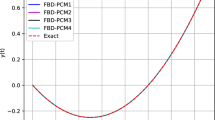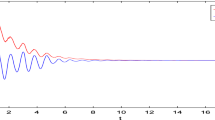Abstract
A new model order reduction (MOR) method for large-scale time-delay differential algebra systems is proposed herein. The presented MOR algorithm is based on parametric moment matching and \(\varepsilon \)-embedding. By selecting an appropriate projection matrix, this process generates reduced-order models that preserve the structure of the original time-delay differential algebra system. Additionally, moment-matching results and error estimations are provided. Finally, two numerical circuits are tested to illustrate the effectiveness of the proposed MOR method.






Similar content being viewed by others
References
R. Achar, M.S. Nakhla, Simulation of high-speed interconnects. Proc. IEEE 89(5), 693–728 (2002)
U. Baur, C. Beattie, P. Benner, Interpolatory projection methods for parameterized model reduction. SIAM J. Sci. Comput. 33(5), 2489–2518 (2011)
U. Baur, P. Benner, Model reduction for parametric systems using balanced truncation and interpolation. at-Automatisierungstechnik 57, 411–420 (2009)
P. Benner, L. Feng, A Robust Algorithm for Parametric Model Order Reduction Based on Implicit Moment Matching. Reduced Order Methods for Modeling and Computational Reduction (Springer International Publishing, Berlin, 2014), pp. 159–185
J. Cullum, A. Ruehli, T. Zhang, A method for reduced-order modeling and simulation of large interconnect circuits and its application to PEEC models with retardation. IEEE Trans. Circuits Syst. II Analog Digital Signal Process. 47(4), 261–273 (2000)
L. Daniel, O.C. Siong, L.S. Chay, A multiparameter moment-matching model-reduction approach for generating geometrically parameterized interconnect performance models. IEEE Trans. Comput. Aided Des. Integr. Circuits Syst. 23(5), 678–693 (2004)
I.G. de La Vega, R. Riaza, Hybrid analysis of nonlinear circuits: DAE models with indices zero and one. Circuits Syst. Signal Process. 32(5), 2065–2095 (2013)
J. Elias, T. Damm, W. Michiels, Model reduction of time-delay systems using position balancing and delay Lyapunov equations. Math. Control Signals Syst. 25(2), 147–166 (2013)
L.H. Feng, E.B. Rudnyi, J.G. Korvink, Preserving the film coefficient as a parameter in the compact thermal model for fast electrothermal simulation. IEEE Trans. Comput. Aided Des. Integr. Circuits Syst. 24(12), 1838–1847 (2005)
R.W. Freund, Krylov subspace methods for reduced order modeling in circuit simulation. J. Comput. Appl. Math. 123(1–2), 395–421 (2000)
A. Ghafoor, M. Imran, Passivity preserving frequency weighted model order reduction technique. Circuits Syst. Signal Process. 36, 4388–4400 (2017)
E. J. Grimme, Krylov projection methods for model reduction. Ph.D. Thesis, Department of Electrical Engineering, University of Illinois at Urbana Champaign (1997)
Y.L. Jiang, Model Order Reduction Methods, 109–115 (Science Press, Beijing, 2010)
Y.L. Jiang, C.Y. Chen, P. Yang, Balanced truncation with \(\varepsilon \)-embedding for coupled dynamical systems. IET Circuits Devices Syst. 12(3), 271–279 (2017)
Y.L. Jiang, H.B. Chen, Time domain model order reduction of general orthogonal polynomials for linear input–output systems. IEEE Trans. Autom. Control 57(2), 330–343 (2012)
Y.L. Jiang, K.L. Xu, \(H_2\) optimal reduced models of general MIMO LTI systems via the cross Gramian on the Stiefel manifold. J. Frankl. Inst. 354(8), 3210–3224 (2017)
Y.L. Jiang, K.L. Xu, C.Y. Chen, Parameterized model order reduction for linear DAE systems via epsilon-embedding technique. J. Frankl. Inst. 356(5), 2901–2918 (2019)
K. Mohaghegh, Linear and nonlinear model order reduction for numerical simulation of electric circuits. Ph.D. Thesis, University of Wuppertal, Germany (2010)
K. Mohaghegh, R. Pulch, M. Striebel, J. ter Maten, Model order reduction for semi-explicit systems of differential algebraic equations, in Proceedings Mathmod 09 Vienna (2009)
J.R. Phillips, L.M. Silveira, Poor man’s TBR: a simple model reduction scheme. IEEE Trans. Comput. Aided Des. 24(1), 43–55 (2005)
E. Rasekh, A. Dounavis, Multiorder arnoldi approach for model order reduction of PEEC models with retardation. IEEE Trans. Compon. Packag. Manuf. Technol. 2(10), 1629–1636 (2012)
S. Reich, On a geometrical interpretation of differential-algebraic equations. Circuits Syst. Signal Process. 9(4), 367–382 (1990)
M. Saadvandi, K. Meerbergen, E. Jarlebring, On dominant poles and model reduction of second order time-delay systems. Appl. Numer. Math. 62(1), 21–34 (2012)
M.G. Safonov, R.Y. Chiang, A Schur method for balanced-truncation model reduction. IEEE Trans. Autom. Control 34(7), 729–733 (2002)
E.R. Samuel, L. Knockaert, T. Dhaene, Model order reduction of time-delay systems using a Laguerre expansion technique. IEEE Trans. Circuits Syst. I Regul. Pap. 61(6), 1815–1823 (2014)
T. Stykel, Balanced truncation model reduction for descriptor systems. PAMM 3(1), 5–8 (2010)
W. Tseng, C. Chen, E. Gad, M. Nakhla, R. Achar, Passive order reduction for RLC circuits with delay elements. IEEE Trans. Adv. Packag. 30(4), 830–840 (2007)
X. Wang, Q. Wang, Z. Zhang, Q. Chen, N. Wong, Balanced truncation for time-delay systems via approximate Gramians, in 16th Asia and South Pacific Design Automation Conference (ASP-DAC), Yokohama, Japan, pp. 55–60 (2011)
Z.H. Xiao, Y.L. Jiang, Dimension reduction for second-order systems by general orthogonal polynomials. Math. Comput. Model Dyn. 20(4), 414–432 (2014)
Author information
Authors and Affiliations
Corresponding author
Additional information
Publisher's Note
Springer Nature remains neutral with regard to jurisdictional claims in published maps and institutional affiliations.
The work was supported by the Natural Science Foundation of China (NSFC) under Grant 61663043 and 11871393.
Rights and permissions
About this article
Cite this article
Qiu, ZY., Jiang, YL. \(\varepsilon \)-Embedding Model Reduction Method for Time-Delay Differential Algebra Systems. Circuits Syst Signal Process 39, 5390–5405 (2020). https://doi.org/10.1007/s00034-020-01426-6
Received:
Revised:
Accepted:
Published:
Issue Date:
DOI: https://doi.org/10.1007/s00034-020-01426-6




